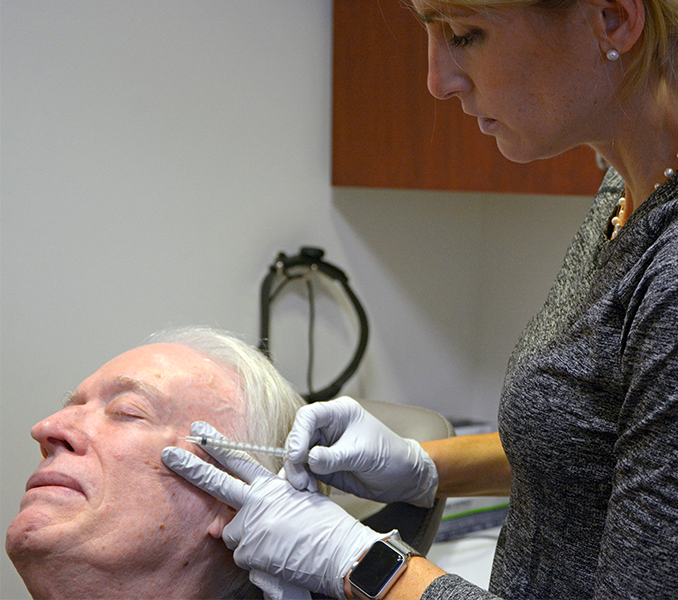Otolaryngology–Head and Neck Surgery
BOTOX® Injections
Overview
While patients with Bell’s palsy usually make a complete recovery, 15-30 percent patients will develop some degree of chronic facial palsy, suffering from facial and neck tightness, and involuntary facial movements in one area of the face during facial expression (this phenomenon is called synkinesis). Other conditions such as Ramsay Hunt syndrome, Lyme disease, acoustic neuroma, and autoimmune disease can also result in long-term facial tightness and synkinesis. These problems arise from abnormal facial nerve regeneration after injury; rather than a lack of regeneration, the recovery can be disorganized or over-zealous. Botulinum toxin (Botox®) is one of the simplest yet most effective treatment for patients with facial tightness and synkinesis from chronic facial palsy.
How Botox Works
Botox works by blocking release of a neurotransmitter called acetylcholine, which is what nerves use to tell muscles to contract or tighten. Therefore, Botulinum toxin relaxes muscles which are too tight and can prevent involuntary facial movements, or synkinesis.
While the Botox we use for facial palsy is the same medication that is used for cosmetic purposes (to decrease wrinkling with facial movement), insurance will typically cover Botox use for patients with facial palsy.
What to Expect
 At the Facial Nerve Center, we are experts in identifying the facial and neck muscles where Botox can be administered to improve facial symmetry or a smile, decrease synkinesis and relieve tightness.
At the Facial Nerve Center, we are experts in identifying the facial and neck muscles where Botox can be administered to improve facial symmetry or a smile, decrease synkinesis and relieve tightness.
We will help patients decide when to begin Botox during the initial consultation visit. We often recommend three or four physical therapy sessions PRIOR to Botox to help patients learn to use their facial muscles better before weakening certain muscles. We will then schedule patients to come in for a Botox visit.
The procedure itself takes less than five minutes and involves a few sticks with a tiny needle to administer the medication to the appropriate muscles. While not common, some patients may experience some light bruising after Botox which will improve with ice and time. The Botox begins working two to five days after administration and the maximal effect is approximately two weeks after the procedure. Botox lasts three to six months, at which time we will see patients back to readminister the medication and titrate the doses and muscles targeted, as necessary.
Our Team
The Facial Nerve Center is staffed by surgeons, physical therapists, physician assistants and other medical specialists skilled in the evaluation and treatment of facial paralysis. Our team includes Kerry Shanley Camp, PA-C, Madeline Macaluso, FNP-BC, Julia Mellon, NP-C, Julia Cambria, NP-C, and Mara Robinson, PT, MS. This combination of medical expertise allows us to help patients improve their appearance, facial function, non-verbal communication and overall well-being.

